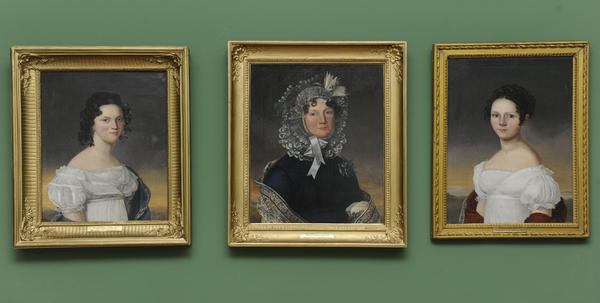The portrait of Natalia Zubova found its way to the museum from Fetinino, ancestral estate of her husband count Nikolai Alexandrovich. His portrait, as well as portraits of other Zubovs, was handed over to the employees by the Leontyev family – the last owners of the estate and the descendants of a famous noble family.
1 / 5
Portrait of Countess N. A. Zubova
Время создания
1810s
Размер
66x54 cm
Техника
Oil on canvas
Коллекция
5
Открыть в приложении#1
Unknow author
Portrait of Countess N. A. Zubova
#14
#2
Countess Zubova was the daughter of a famous military leader Alexander Suvorov. Due to endless military campaigns he rarely saw his beloved ‘Suvorochka’, but he constantly wrote her letters.
Walker James (1748 - after 1808). Portrait of Alexander Vasilievich Suvorov-Rymniksky, 1797. Engraving. Paper, mezzo tinto. GVSMZ
#3
Suvorov’s relationship with his wife was not easy, so Natalia was sent to Smolny Institute when she was still a child. Upon graduation, future countess became the maid of honour of Catherine II. It was the Empress who arranged the family life of the girl – she approved of count Nikolai Zubov (who was the older brother of Platon Zubov, Catherine’s minion) as her husband.
However ten years of marriage did not bring ‘Suvorochka’ happiness. According to the memoirs of the contemporaries Zubov had a very crude and bad temper, and in 1801 he became one of the main participants in the assassination of Paul I. The coup resulted in Alexander I ascending the throne. Later the Emperor designated Zubov as the Master of the Horse and made the Chief of the Royal Household Stables. Yet, two years later, the count was removed from the seat for ‘brutal high-handedness with coachmen’.
However ten years of marriage did not bring ‘Suvorochka’ happiness. According to the memoirs of the contemporaries Zubov had a very crude and bad temper, and in 1801 he became one of the main participants in the assassination of Paul I. The coup resulted in Alexander I ascending the throne. Later the Emperor designated Zubov as the Master of the Horse and made the Chief of the Royal Household Stables. Yet, two years later, the count was removed from the seat for ‘brutal high-handedness with coachmen’.
#5
Unknown artist. Portrait of Countess N. A. Suvorova. 1795 - the beginning of the XIX century. Copy of the portrait of the brush D.-B. Lumpy (?). 1795 Oil on canvas. 72 × 57. GMVMZ
After the death of Nikolai Alexandrovich in 1805, countess Zubova devoted herself to raising her six children and 14 grandchildren. She firmly held by the ears both her family matters and numerous affairs of the estate.
#6
An entire gallery of portraits of the noble Zubov family is preserved in the Vladimir and Suzdal State historical, architectural and art museum-reserve. An entire gallery of portraits of the noble Zubov family is preserved in the Vladimir and Suzdal State historical, architectural and art museum-reserve.
Unknown artist. Portraits of N. A. Zubova and her daughters Olga and Lyubov. GMVMZ
#7
A consistent manner of works and similar stylistic details make art historians believe that they were written by the same master. In the old museum documentation Henri−François Riesener, famous portraitist of the court, was registered as the author of the paintings, however this supposal of his authorship was not confirmed. Then the staff of the Grabar Conservation Centre suggested that these works were copies of not preserved Riesener 's paintings, which he created in the early romantic period of his artwork. The name of the copyist could not be identified.
In the portrait, Natalya Alexandrovna is depicted in a dress that corresponds to her status of the mother of the family: in a blue striped high-necked dress, a white lace cap, and a patterned, but sombre coloured shawl. The artist depicted features of the countess’s appearance in such a way that the viewer can guess some aspects of her personality, for example: calmness–- seen through her noble posture; insight and wisdom – a sharp look; sensibility – dark-red curls visible from the cap.
In the portrait, Natalya Alexandrovna is depicted in a dress that corresponds to her status of the mother of the family: in a blue striped high-necked dress, a white lace cap, and a patterned, but sombre coloured shawl. The artist depicted features of the countess’s appearance in such a way that the viewer can guess some aspects of her personality, for example: calmness–- seen through her noble posture; insight and wisdom – a sharp look; sensibility – dark-red curls visible from the cap.
читать дальшескрыть
00:00
00:00
1x
Portrait of Countess N. A. Zubova
Время создания
1810s
Размер
66x54 cm
Техника
Oil on canvas
Коллекция
5
Открыть в приложении
Поделиться



